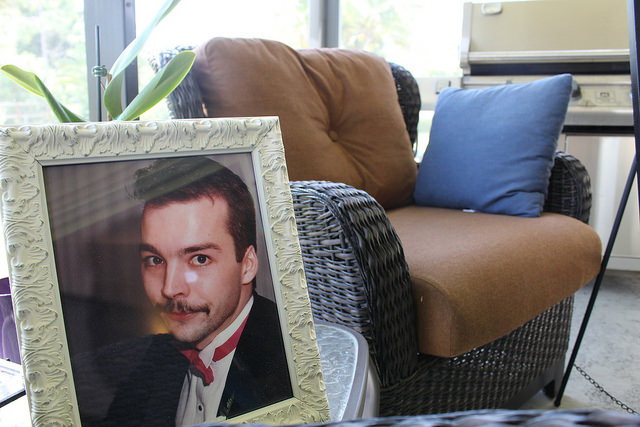Angela Tennell keeps a photo of her son David Neering, who died of a drug overdose in 2016 after years or dealing with an opioid addiction. Photo by Li Cohen
As red and blue waves continue clashing in Florida in the race for the governor’s mansion this November, a hurricane of people in the general public are fighting for the lives of those battling a politically forgotten crisis.
Palm Beach Gardens resident Angela Tennell has watched gubernatorial candidates Ron DeSantis, Republican, and Andrew Gillum, Democrat, campaign for months. Throughout their election coverage, neither candidate has established a set plan to battle the opioid crisis, an issue that has rampaged throughout the nation and caused significant devastation in South Florida. The crisis has had a devastating impact on her life. Her son’s opioid addiction killed him.
As Tennell watches the two men campaign, she can’t help but recall the words of her son, David Neering – ‘Mom, you’re going to outlive me.’
“It killed me. He goes, ‘I’m going to die’,” Tennell tearfully recollected. “No parent wants to outlive their child.”
In Florida, far too many have. Her son is just one of thousands who have overdosed from opioids in the state. Despite the 5,725 opioid-related deaths reported in Florida in 2016 and the continuing increase of drug use and synthetic drug manufacturing in the state, DeSantis and Gillum have yet to announce detailed plans of action.
DeSantis’ public statements on the issue include only a Tweet linking to a Washington Examiner article about an increase in fentanyl confiscations at the U.S.-Mexico border. His solution in the post references President Donald Trump’s call to build a wall. This position was reiterated during one of his rallies in West Palm Beach on Oct. 6.
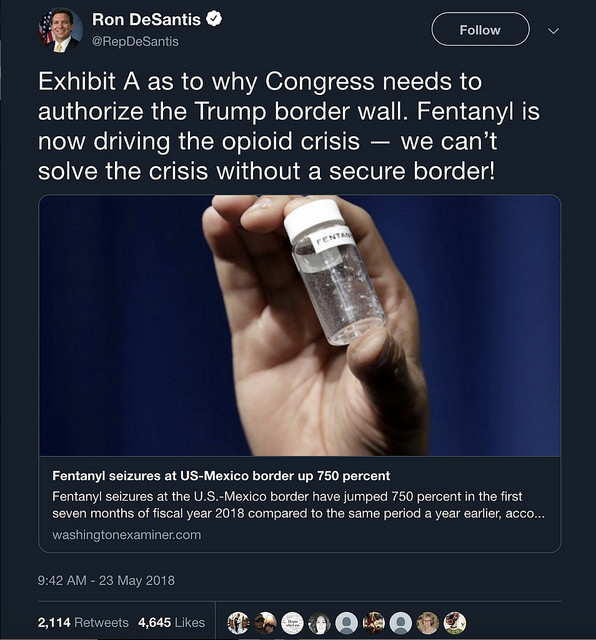
“China’s sending a lot of this fentanyl to Central America. They’re bringing it across the border,” he said. “We’re intercepting a lot of it, but I mean this is really nasty dangerous stuff that can kill a lot of people and he (Gillum) just wants to let it come across the border with no enforcement.”
Gillum has not outlined any specific plans in his recent statements, but in an op-ed for the Palm Beach Post in July 2017, Gillum wrote a general plan to address the crisis.
“… We are going to create a statewide task force of law enforcement, first responders and mental health and patient advocates to address opioids at the state level,” he wrote. “We should restore the $11 million cut in state mental health funding, create opioid intervention courts and work with our Congressional delegation to secure more federal funding.”
Although Gillum had more direct suggestions, neither candidate has offered specific plans on how and when they will address the issue in office. Neither DeSantis nor Gillum responded to requests for comment about the issue.
Addressing the root of the issue
In the past, pharmaceutical companies shared the majority of the blame in the opioid crisis.
State Attorney for Palm Beach County Dave Aronberg explained that the state specifically targeted ‘pill mills – facilities that fraudulently provide addictive substances to patients being treated for substance abuse. While prescription drugs still play a major role in the epidemic, a large source of opioids for addicts is now a synthetic drug called fentanyl.
“The stuff that’s coming in from China is fentanyl and its analogs. That’s where the majority of the death rate is coming from,” Aronberg said. “The pills are more of a problem in that they get people hooked on opioids which eventually leads them to seeking out heroin and fentanyl.”
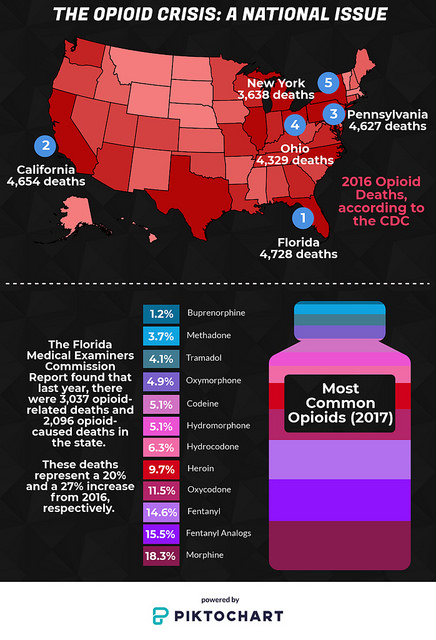
Fentanyl and fentanyl analogs are some of the most addictive and dangerous opioids available, with potency that can be 100 times more than morphine, according to the National Institute on Drug Abuse. The number of deaths due to fentanyl and fentanyl-analogs in Florida has steadily increased since 2007, but since 2015, the state has seen a dramatic surplus of this cause of death. The 2017 Medical Examiners Commission Interim Drug Report states that in the first half of 2017, the number of reported opioid-related deaths increased by 20 percent and the number of opioid-caused deaths increased by 27 percent. The presence of fentanyl increased by 1 percent and of fentanyl analogs by 383 percent.
Area locals agreed that neither of the candidates are addressing the issue enough, especially in regards to attacking the source of the problem head-on.
Hollywood, Florida resident Linda Schainberg plans to vote for DeSantis, and even though she believes that building a wall will help enforce immigration issues, she does not believe that his priority of building a wall to address the opioid epidemic in South Florida will solve the problem. She would like to see him incorporate more of Gillum’s ideas on the issue. Schainberg believes that she can count on his impact in office because he falls “under the umbrella” of Trump’s political stances.
“I’m sure he will be (held) accountable for (addressing) opioids, education, gun control, all those things. That’s what he’s been campaigning for,” she said. “He’s adhering to the Make America Great Again agenda and that’s it. That’s why I’m voting for him. That’s less government; that’s education; that’s the opioid crisis.”
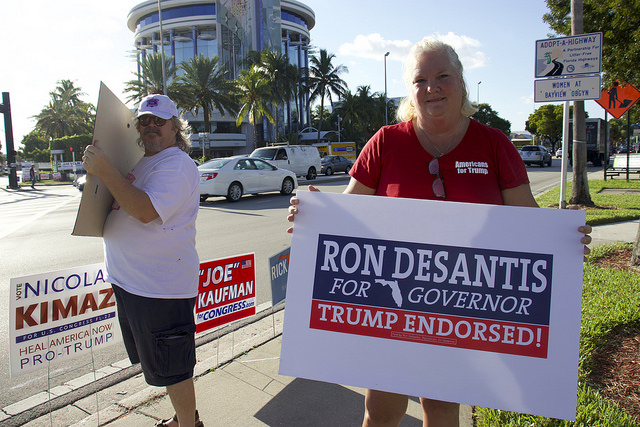
Robert Korhonen, left, and Linda Schainberg, right, held an unofficial rally for Ron DeSantis on the side of the road in South Florida on Oct. 5. Photo by Li Cohen
Robert Korhonen, who also plans to vote for DeSantis, said he has not heard the candidate mention the crisis at length, despite attending many of his speaking events. He believes that building a wall will help address the issue, but also acknowledged that pharmaceutical companies should share some of the blame in the high rates of addiction and overdoses in the state.
“There are all kinds of drugs, illegals and disease; they’re bringing all kinds of crap across the border. It’s just flooding over the borders and has been for a long, long time,” he said. “(The wall) will stop the flow of opioids from the southern border to the United States. At least it’ll help that. It comes from other places, too, like Canada or whatever.”
Aronberg supports Gillum’s candidacy, and said that Gillum’s emphasis on expanding Medicaid is a vital component to eliminating the epidemic.
“I haven’t heard anything from DeSantis on the opioid crisis,” he said. “As governor he doesn’t have anything to do with the wall. That’s not a Florida solution, that’s a federal issue and that’s not even a solution in my opinion. Even if it were, being governor of Florida has nothing to do with it.”
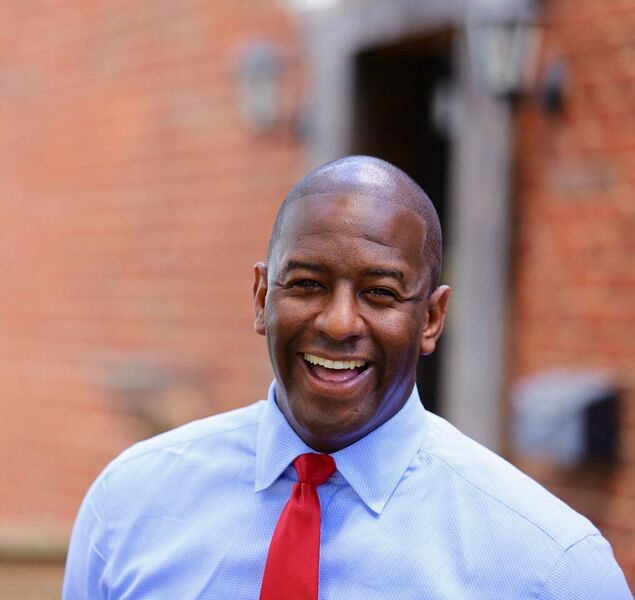
Andrew Gillum, Democrat, is running against Ron DeSantis for to be Florida’s next governor. Photo courtesy Andrew Gillum
Gillum supporter Ted Young hasn’t heard either candidate spend a lot of time on the opioid epidemic.
“I would definitely say that if people have opioid addictions then we need to deal with addiction like we do any kind of sickness or medical issue,” Young said.
The overshadowing of an epidemic
Gillum and DeSantis have each campaigned for months on the hot button issues of education, gun control and the environment. While those issues are crucial to discuss for Florida’s future, the candidates have not responded to an epidemic that is costing thousands of lives.
Tom Conrad is a former addict, now in his eighth year of sobriety. He runs the rehab and treatment facility Rock Recovery Center in West Palm Beach to help others struggling with addiction. While he did not disclose which candidate he is voting for this November, he said that the opioid crisis has never truly been at the forefront of politics. He is “keeping his fingers” crossed that tangible changes are made with a new governor in office.
“I don’t think it’s ever really been something that has been that focused on,” he said. “I don’t see it getting better if it keeps going the way it’s going … I don’t know what their plan is, but something has to happen for sure.”
Ben Bueno, an former opioid addict who grew up in South Florida, is the chief operating officer of Rock Recovery. He echoed Conrad’s beliefs on the matter and also chose not to disclose which candidate he plans to vote for.
“I don’t want to have unrealistic expectations,” he said. “If a governor talks about, as part of their campaign, that they’re going to do something about the opioid epidemic, a part of me jumps for joy inside. But then reality sets in, like what does that really mean? Nothing changes.”
In regards to whether a wall would stop the infiltration of drugs in South Florida, he added, “You will never stop drugs from coming into the U.S. We’re the richest, most powerful country in the world. We’re the biggest drug market. Last I checked, Mexico was sending drugs through tunnels underground so I don’t think a wall’s going to stop that. The War on Drugs lost.”
Within Florida, there are 522 facilities that provide substance abuse treatment, according to the 2016 report published by the Substance Abuse and Mental Health Services Administration (SAMHSA). Of those, only 51 offer SAMHSA-certified opioid treatment programs and only 15 of those SAMHSA-certified program facilities receive any kind of state or government funding to help with the cost of treatment.
While SAMHSA-certification is not required to become an accredited facility, the certification process requires that the facility maintain state and federal opioid treatment standards. SAMHSA regularly inspects and surveys the facilities and mandates that the facility has a program sponsor, medical director, quality assurance and control plan, trained and educated staff, maintenance treatment, detox treatment, assessment services, and more.
Manny Llano, CEO of Fort Lauderdale Behavioral Health Center, runs one of the few SAMHSA-certified facilities in the state. He believes that neither of the candidates have offered a comprehensive solution to address the crisis happening in Florida. Even though the Behavioral Health Center offers certified treatment and recovery programs, including in-patient and out-patient services available to individuals with a wide variety of insurance carriers, he said that people who do not have insurance tend to suffer.
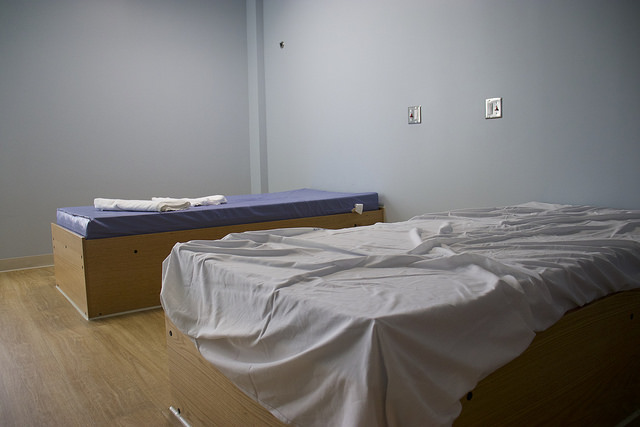
At Fort Lauderdale Behavioral Health Center, patients who come in for substance abuse and placed in in-patient programs stay in empty rooms with built-in furniture and ample sunlight in an effort to minimize potential harm. Photo by Li Cohen
“I think controlling the borders is important, but having more funding and access to be able to provide services is also the solution,” he said. “A crucial point for us is to be able to have some control over the insurance companies to ensure that services are being provided and that they’ll have open access to funding so that more services can be added to people in need.”
The ending of midterm campaigns, the continuation of a problem
As the midterm campaigns quickly approach their end on Nov. 6, Gillum and DeSantis’ campaign trails have left numerous proposals to better regulate gun control, improve the environment and reform education for students and teachers. Florida residents and treatment facility owners, however, believe the devastating impact of Florida’s forgotten crisis will remain.
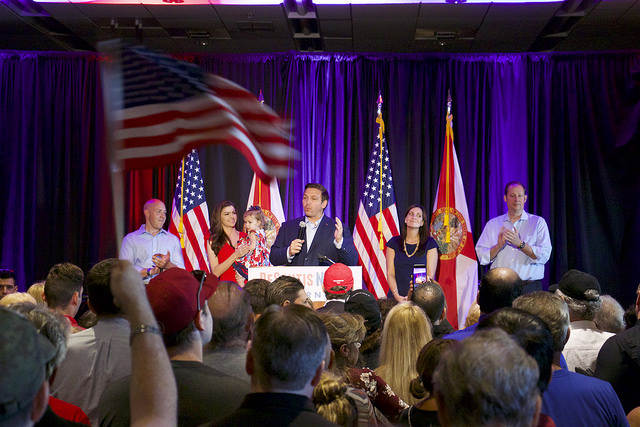
Ron DeSantis, center, addresses the crowd at the Palm Beach Convention Center on Oct. 6 about his plans as governor of Florida if he wins the midterm election, none of which include addressing the opioid crisis. Photo by Li Cohen
A former treatment facility owner – who wished to remain anonymous due to a pending FBI investigation into his facility – explained that politicians are failing to address the cost of running a treatment program. A former addict who started using drugs at 15, he has found that the funding and uniform front needed to combat the issue is nonexistent from the government side. He said that insurance companies don’t want to pay for treatment in halfway houses, causing facility owners to struggle between running an underfunded business and providing a much-needed service to an underserved population.
“It becomes an ethical line of where do you draw the line between helping people and paying the bills. The whole system is not set up for success,” he said. “From detox to halfway houses, the entire system needs to be restructured to be more effective.”
He said within the facility he ran, a detox might cost $3,500 to $4,000 per client per day, not including tests and bloodwork.
“I think all the politicians are worried about are their elections and what can further their careers, so I don’t think anybody really cares on that level,” he said. “It’s so hard to have a unified front because there are so many factions of the government – state, local, federal – and everybody has a different opinion. Then they get elected and nothing happens.”
With only a few weeks left before the final vote, Tennell has only a few words for Gillum and DeSantis to take with them during their final rallies.
“I lost my son. My sister, she’ll never be right. My grandson, his life is hell right now. It pains me … This is very wrong, what’s happening. So many people have lost a friend, a brother, a sister,” Tennell said. “The crisis needs to be covered. It’s not going to go away. There’s no turning your head away from this. If we don’t address this problem, people will still be dying every day, every hour, every minute, every second.”
